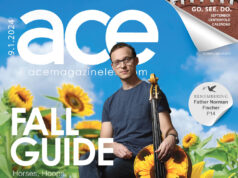Indigo Girls
Two into one
By Alan Sculley
The musical image of Emily Saliers and Amy Ray-the duo who make up the Indigo Girls-are distinctly different enough that sometimes it seems as if this could be two solo artists operating under the umbrella of a group. After all, Saliers and Ray write separately. And on any Indigo Girls album, it’s usually pretty obvious which of the two women wrote which songs. Ray is the one more likely to have written the edgier, harder rocking tunes, or the stark acoustic material. Saliers usually has a more delicate, poppier feel to her material and favors a mid-tempo setting for many of her songs.
Even their performances are often as much about contrast as similarities. Ray is the one with the huskier, rougher edged voice, while Saliers soprano is usually sweet sounding and light. On guitar, Ray is the one who usually does the brisker, more riff-based playing, while Saliers favors more of a finger-picked sound.
But Saliers made it clear that there’s also a merging point that is very responsible for creating what is truly an Indigo Girls sound. “Our arrangements really bring the songs together,” Saliers said. “That’s what makes an Indigo Girls song an Indigo Girls song. For me personally, every time I go back and play a song that I wrote on my own, I think it’s better with what Amy put on it. So even though our voices are different and a lot of times our sensibilities (are different) and we have very different personalities-a lot of times we seem polar opposites even to ourselves-when we arrange the songs together, that’s what makes them Indigo Girls songs.
“It’s sweet and sour really, and the differences work well together,” Saliers said. “And for me I never get bored because I know Amy is going to come up with a batch of songs that I could never write like that. But I get to put my creative parts to it. So I have my songs, which fulfill me in their own ways because they’re my songs. And then I have Amy’s songs, which fulfill me in a completely different way because it’s a whole other musical thing. So there’s a lot of that going on.”
When the Indigo Girls made their first real impact with their 1987 full-length debut CD, Strange Fire and their 1988 self-titled CD (their first major label release), they were immediately pigeonholed as a folk act. That was fair enough since those albums were largely acoustic, vocal-based works that showed a social conscience that’s always been associated with folk.
But as further albums followed, Ray and Saliers gradually expanded their sound, and Ray and Saliers expanded into electric instrumentation and embraced a wider range of styles that included pure pop, brisk rock, and even a touch of soul.
But their latest CD, Become You, is being seen as a return to the Indigo Girls’ roots. Although it was recorded with a full band, it’s predominantly acoustic and far more stripped down than the recent Indigo Girls CDs.
“We intentionally were going to make an acoustic record,” Saliers said. “We set out to do that, which is a little unusual for us. Usually we just kind of write the songs, get in the studio, invite some people and create it like that. But we knew the band we wanted to use, and we used the same band throughout the whole record. It harkens back to the early sound because it is very bare and acoustic, but on the other hand shows an evolution as writers to a certain extent.”
So while Become You doesn’t break as much stylistic ground as the recent albums did, Saliers is right in pointing out the quality of the songs on Become You.
Acoustic-based ballads like “Collecting You” and “Deconstruction” could fit alongside the gentler music on the Indigo Girls’ first three albums, and the rambling “Yield,” and the edgy “Starkville” are also easy fits within the signature sound those initial albums established.
Meanwhile, the CD gets the variety it needs through some judiciously applied contrasts in instrumentation. The song “Become You,” for instance, takes on a fresh feel with its use of accordion as a key source of accompaniment. “You’ve Got To Show” gets a different accent with its Latin cadence that gets fully highlighted by a brief, jazz-tinged saxophone solo.
As much as anything, Become You stands out for the sense of confidence and spontaneity that shines through in the music and the performances. Become You, which was released last spring, followed a break from recording and touring that saw Ray fulfill a long-standing ambition to make a solo record. Ray also toured behind that punky effort which was entitled Stag.
Saliers said she felt the time off had a direct effect on her songwriting, which she considers to have reached a new high point on Become You.
“I definitely felt fresh when I was writing the songs and I definitely, just for me and my songs personally, I felt that I had all the time in the world to write them, which is nice. I don’t like to work under pressure,” Saliers said.
“I also felt really comfortable with the songs when they were written. I felt like I liked them and it didn’t really matter if anybody else liked them at first. I really felt good about them. That was kind of a switch for me. I think I’m growing into my own voice. And it’s taken me a long time, but I sort of feel myself coming to some sort of creative fruition and giving myself the space and time. Getting off the road was important for that.”







